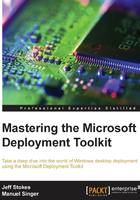
What this book covers
Chapter 1, Imaging Concepts and Theory, covers the basic terminology of imaging, when to use thick versus thin versus hybrid images, and why deployment changed in Vista and higher versions. Furthermore, the reader will learn the concepts behind reference image versus deployment image, where to integrate patches and why, and what apps and drivers are from the MDT perspective.
Chapter 2, Setting Up Your Environment, explains how to construct an MDT environment from scratch. This chapter will be a walkthrough of the different installation options and will explain why I recommend a particular configuration for production environments.
Chapter 3, Creating Reference Images, helps to understand the principles of a reference image and how it applies to the organization. Sysprep practices, patching, maintenance, and bitness will be covered in depth.
Chapter 4, Default User Profile Customization, covers the intricacies of customizing the default user profile from version to version of Windows. Tools and concepts available to brand the image, tweaking settings prior to deployment, and supported methods of doing so will be discussed in this chapter.
Chapter 5, CustomSettings.ini and Task Sequence, covers the CustomSettings.ini file and task sequence engine in detail and depth. Tips for customizing the deployment share, enabling logging, branding, and more will be covered here.
Chapter 6, Drivers, explains how driver handling can be a challenge for larger organizations. We’ll cover driver concepts, when drivers are applications and when they are drivers and how to handle both scenarios, and also mandatory driver profiles.
Chapter 7 , Image Deployment, focuses on the deployment share configuration, deployment best practices, and guidelines on securing the deployment share.
Chapter 8, USMT - The User State Migration Tool, covers USMT in depth, configuration of XML files, walkthroughs of the process, and troubleshooting. This also includes XML configuration and customization, USMT process top to bottom, and troubleshooting.
Chapter 9, Troubleshooting Deployment Logs, shows what to do when things go wrong. How to read MDT logs, which log file contains what data, how to interpret the binary error codes, and frequent pitfalls will be covered as well. We will also cover error code resolution, MDT log files, Trace32, and error messages.
Chapter 10, Validating the Image, covers Driver Verifier and Windows Performance Toolkit for image validation scenarios. We will talk about different tools that can be used to validate the image, check for bad drivers and poor performance, articulate the cost of purchasing lower-end hardware for management, and the operational and performance costs of anti-malware, antivirus, and other security-auditing software.
Chapter 11, Database, UserExit Scripts, and Web Services, explains the ability to web frontend the MDT implementation, as well as how to utilize the database capabilities of MDT for deeper deployment options. Also, we’ll discuss a little about UserExit scripts. We’ll get into the whys and hows of UserExit scripts, what options are available, and when to use them.
Appendix, Additional Enterprise Configuration Items, discusses some considerations of the Windows 10 tool set, as well as some configuration suggestions for secure environments.